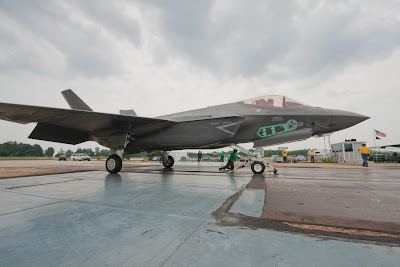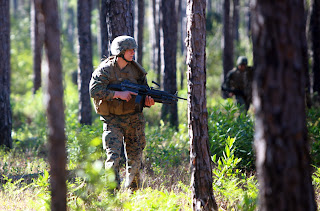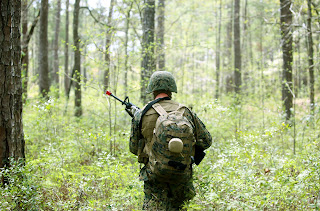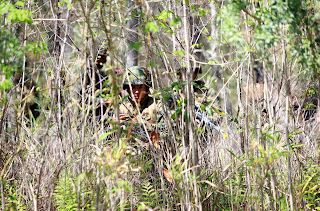via Navy News Service.
EGLIN AFB, Fla. (NNS) -- Navy personnel are busy preparing to teach the
next generation of Sailors how to work with and fly the newest military
aircraft, the F-35C Lightening II Joint Strike Fighter, as Strike Fighter Squadron 101 (VFA-101) readies for its stand-up ceremony on Eglin Air Force Base May 1.
The F-35 is a single seat, multi-role fighter aircraft with the
capability to perform ground attack, reconnaissance, and air defense
missions. The aircraft is in full production at the Lockheed Martin
plant in Fort Worth, Texas. The F-35 is designed to eventually replace
the F/A-18 Hornet and AV-8B Harrier tactical fighter aircraft and was
planned with a common design, but three unique service variants, to keep
development, production, and operating costs down.
"This is brand new aircraft platform from tooth to tail," said Cmdr.
Scott Kartvedt, commanding officer of VFA-101. "We're not parlaying off
any Navy stealth legacy programs or support systems. This will be the
first new stealth and carrier-based tactical fighter aircraft since the
introduction of the F/A-18 29 years ago."
The original Fighter Squadron 101 (VF-101), nicknamed the "Grim
Reapers," was established May 1, 1952 and flew various models of fighter
aircraft including the F-4 Phantom and F-14 Tomcat. With the retirement
of the F-14, VF-101 was disestablished in 2005.
To support the new Navy version of the F-35, VFA-101 will be
reestablished May 1 at a new hangar and training facility on Eglin AFB
and will serve as the Fleet Replacement Squadron (FRS), training pilots
and maintainers for the fleet.
The first Sailors to help stand up VFA-101 will receive 'Plank Owner'
certificates for their assistance with the new aircraft, new training
facilities and redesignated squadron. As per Navy tradition, plank
owners are individuals who were members of the crew of a ship when that
ship was placed in commission.
"I'm learning a lot and really enjoy working with other services," said
Senior Chief Logistics Specialist (AW/SW) Mirtha Martinez, Material
Control Department leading chief petty officer for the squadron. "I'd
love to come back in five years and see the squadron fully functioning."
Marine Col. Arthur Tomassetti, vice commander of the 33rd Fighter Wing,
said establishing a squadron to train and work with the F-35 aircraft
has not been easy, but the leadership has taken charge and is working
towards building the best facilities possible to work with this new
aircraft.
"The concept was simple; establish an initial training center for pilots
and maintainers for the F-35 weapon system," said Tomassetti. "Bringing
that concept to reality has been and will continue to be complicated
and challenging. So the first step is you start with the best people you
can find, put them together, and say 'go.' Over the past
two-and-one-half years, those carefully selected people have put
together a strategy, developed plans, adapted to the dynamic and ever
changing environment and schedule, and continued to track towards the
goal of establishing a training center for F-35 pilots and maintainers."
The mechanics of the Navy F-35 will initially be taught by Lockheed
Martin personnel to Navy instructors, who will then begin teaching
students after completing instructor certification. Students are
expected to arrive for maintenance instruction in 2015, with the first
F-35s scheduled for deployment 2017-2018.
The Navy's version of the F-35, the 'C' model is distinct from the F-35A
and F-35B versions with larger wing surfaces and reinforced landing
gear for greater control in the demanding carrier take-off and landing
environment.
Sailors in the majority of aviation rates are eligible to attend the
F-35 course of instruction, including aviation ordnancemen, aviation
structural mechanics, aviation machinist's mates, aviation electronics
technicians, aviation electrician's mates, aviation structural mechanics
and aircrew survival equipmentmen.
VFA-101 is a part of the 33rd Fighter Wing, a joint-service graduate
flying and maintenance training wing responsible for F-35 A/B/C pilot
and maintenance training for the Navy, Marine Corps, and the Air Force.
Initially, 59 aircraft and three flying squadrons, one for each
service's aircraft variant will be based at Eglin Air Force Base, Fla.
The F-35 Academic Training Center serves as the schoolhouse, where wing
personnel expect to train more than 2,000 maintenance students and 100
pilots each year.
So the gang is all there.
All three services have units in place to begin training.
On this one subject the Commandant being an Aviator probably helps. On this he'll push like a madman to get this started...the AAV and MPC programs might lag but the training will start up before the end of this year.
Oh and check other spots to see if this is reported.
It won't be.
They'll report dubious information....like a 50 year estimated life cycle cost of the F-35...but they won't report this certified fact.
Amazing.








